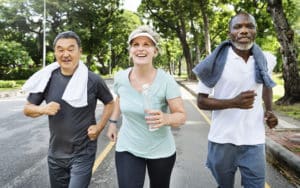Why are carbohydrates under-consumed by active adults?
Active adults often do not consume sufficient carbohydrate to replenish muscle and liver glycogen stores. The reasons include misinformation about carbohydrate nutrition and inadequate understanding of basic sports nutrition concepts. Carbohydrate is unique in that it is used to fuel endurance or aerobic exercise and it is the only fuel that can be used without oxygen, or anaerobically, for intense, all-out effort, like sprinting or jumping. Without sufficient carbohydrate, exercise feels harder, skills and concentration decreases, and fatigue sets in more rapidly.
How many carbohydrates should an active person consume?
It depends on the intensity and duration of exercise, but an active person’s diet should contain 50-65% of their total daily calorie intake as carbohydrates. For those involved in activities such as recreational golf, baseball, or softball, 3-5 g/kg/BW/day or 1.36-2.27 g/lb/BW/day is recommended. For those involved in moderate-intensity exercise for an hour each day, more carbohydrate is needed. Aim for 5-7 g/kg/BW/day or 2.27-3.18 g/lb/BW/day.
How many carbohydrates should be eaten before exercise?
If the exercise last longer than 60 minutes, it is best to eat a few hours before exercise to give the body time to digest the meal and deliver the carbohydrate to working muscles. If you can’t eat before exercise, a small carbohydrate-rich snack of 25-30 grams of carbohydrate can help power you through exercise. Examples include a mini-bagel, 2 fig cookie bars, medium apple, 1 cup of oatmeal, 17 mini-pretzels, a toasted English muffin, or a small blueberry muffin.
Are carbohydrates needed during exercise?
If exercise lasts for 1 to 2.5 hours, 30-60 grams of easy to digest carbohydrates (such as a beverage or gel) can be taken to provide an additional source of fuel to supplement glycogen stores.
How many carbohydrates should be eaten after exercise?
If a meal will be eaten with a within hours of exercise, include carbohydrate with the meal. If the exercise event is an all-day or multiple day tournament (such as tennis or soccer matches), consume small carbohydrate-rich snacks in the hours after exercise. A peanut butter and jelly sandwich with a fruit cup will provide ample carbohydrate for speedy refueling.
Is carbohydrate loading needed for exercise?
Carbohydrate loading is a method to supersaturate the muscles with stored carbohydrate, called glycogen. It can be beneficial for events that last greater than 90 minutes, such as running a marathon or cycling race. For most active people, carbohydrate loading is not needed if they eat a carbohydrate-rich diet in the weeks leading up to an exercise event. One downside of carbohydrate loading is that the extra stored glycogen also stores extra water, making some athletes feel heavy or bloated.
Should athletes eat only low glycemic index foods for better performance?
Glycemic index, an indicator of how a food affects blood sugar levels, has not been shown to improve performance across a variety of different types of exercise. However, the glycemic index can be used as a tool to choose carbohydrate foods for specific exercise situations. For example, foods with a high glycemic index (such as sports drinks, some breakfast cereals, and bread) can help maximize muscle glycogen stores more rapidly than low glycemic index foods (such as milk, yogurt, pasta) when there is limited recovery time between workouts. Glycemic index is a tool that can help athletes fine tune their diet, but should not be used exclusively to plan diets for active people.

